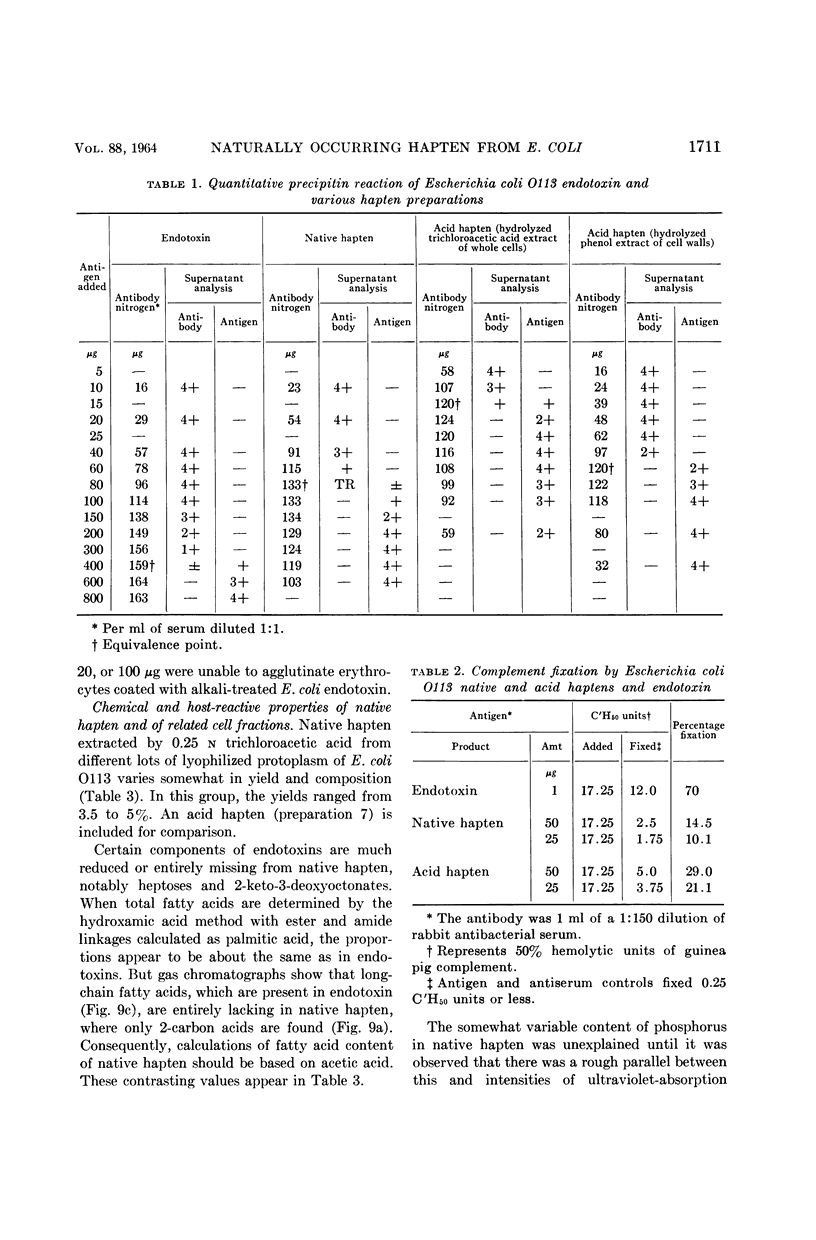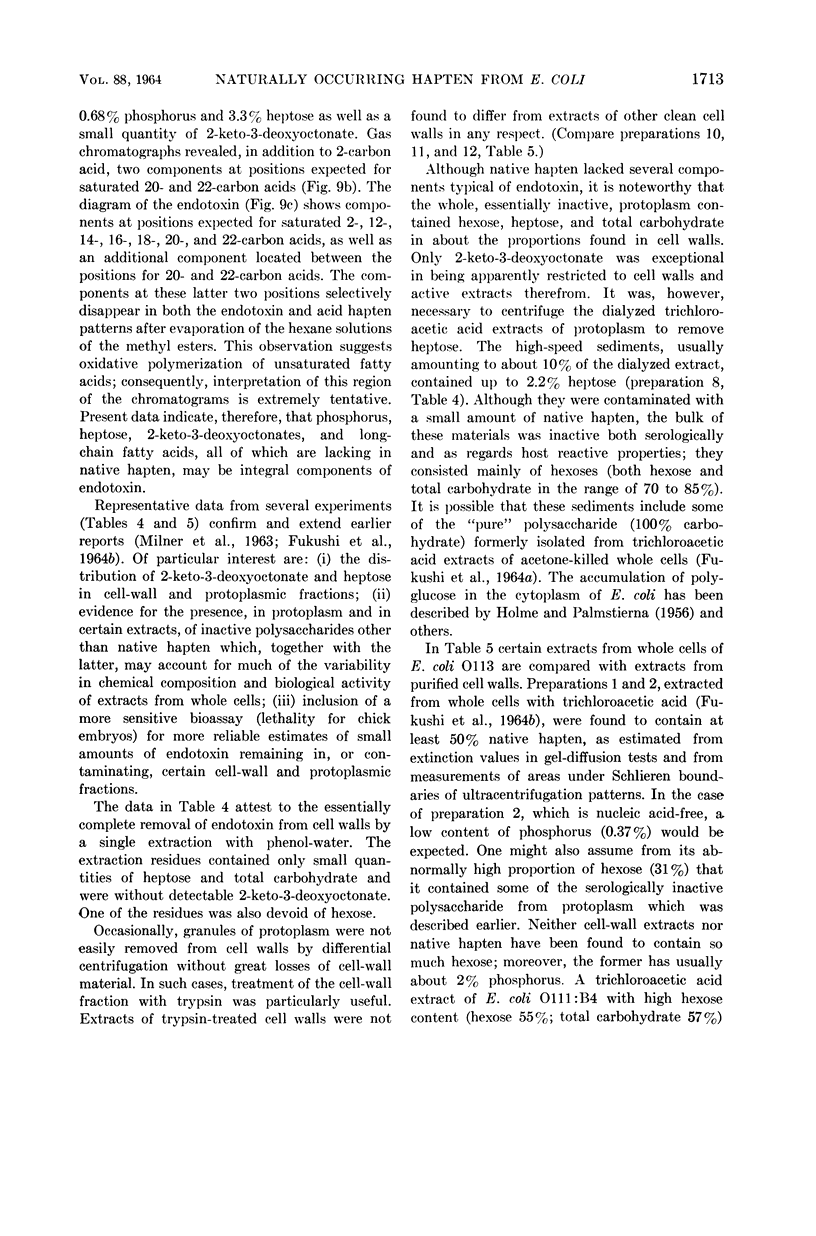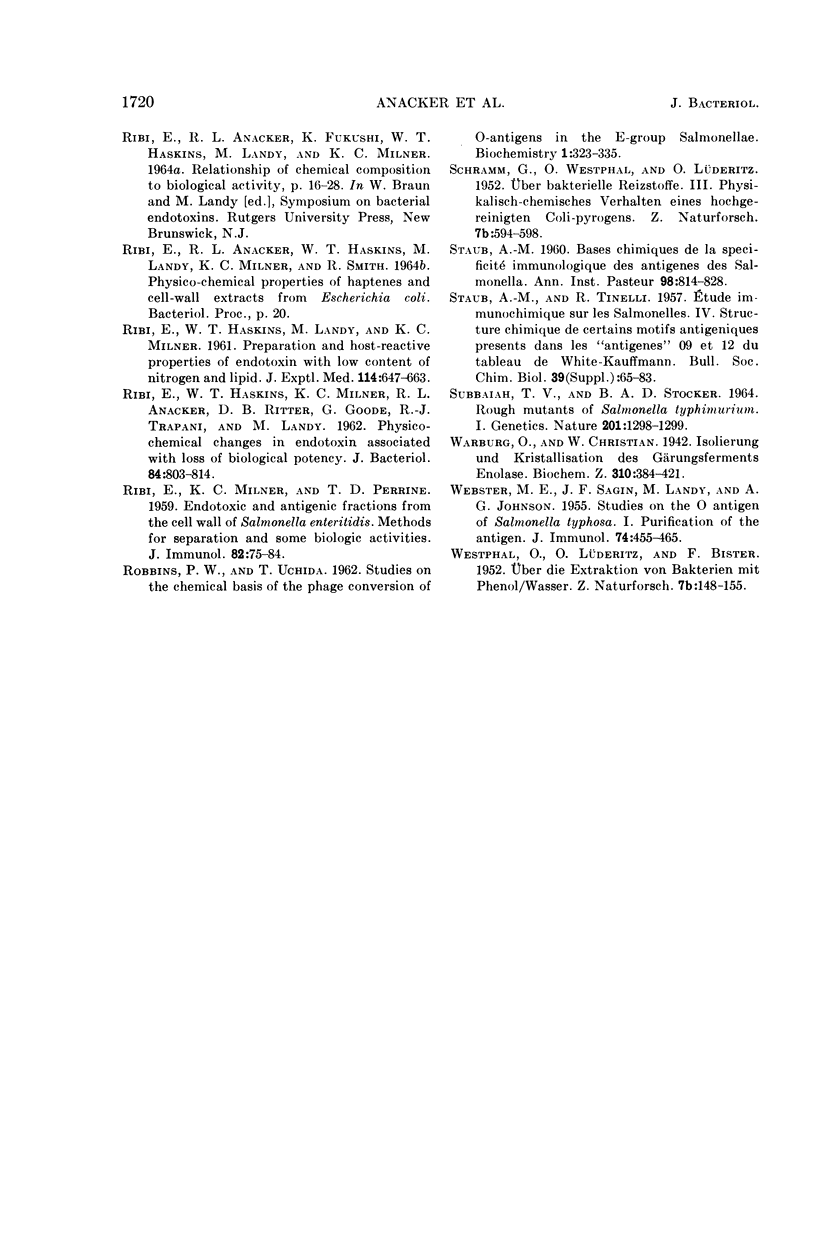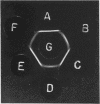Abstract
Anacker, R. L. (National Institute of Allergy and Infectious Diseases, Rocky Mountain Laboratory, Hamilton, Mont.), R. A. Finkelstein, W. T. Haskins, M. Landy, K. C. Milner, E. Ribi, and P. W. Stashak. Origin and properties of naturally occurring hapten from Escherichia coli. J. Bacteriol. 88:1705–1720. 1964.—Haptens found in preparations of endotoxin and in fractions of disrupted cells, particularly one termed “native hapten,” which appeared to be associated with the protoplasm of cells rather than with cell walls, have been further investigated with a view to establishing their origin and composition as well as their host-reactive properties. For this purpose, cells from a smooth strain of Escherichia coli O111:B4 were either extracted directly or disrupted and separated into cell-wall and protoplasmic fractions. Haptens were obtained by gel filtration of endotoxins, by trichloroacetic acid extraction of protoplasm, and by a mild acid hydrolysis of endotoxin. Several lines of evidence indicated that native hapten originated in the protoplasm rather than by autolysis or degradation of cell-wall endotoxin during procedures employed in disruption. In gel diffusion and quantitative precipitin tests, no hapten was identical with endotoxin, but native hapten was serologically the most complex of the haptens and precipitated the most antibody. Native and acid haptens, on a weight basis, fixed about 1% of the quantity of complement fixed by homologous endotoxin. Haptens did not stimulate the production of antibodies in mice or rabbits and did not elicit endotoxic host reactions. Chemically, native hapten differed from endotoxin and from acid hapten in that it lacked phosphorus, heptose, long-chain fatty acids, and 2-keto-3-deoxyoctonate. These substances did not appear to be determinants of antigenic specificity, but they may provide necessary bonds for assembling hapten-like units into fully antigenic and toxic macromolecules.
Full text
PDF















Images in this article
Selected References
These references are in PubMed. This may not be the complete list of references from this article.
- BECKMANN I., SUBBAIAH T. V., STOCKER B. A. ROUGH MUTANTS OF SALMONELLA TYPHIMURIUM. II. SEROLOGICAL AND CHEMICAL INVESTIGATIONS. Nature. 1964 Mar 28;201:1299–1301. doi: 10.1038/2011299a0. [DOI] [PubMed] [Google Scholar]
- FINKELSTEIN R. A. OBSERVATIONS ON MODE OF ACTION OF ENDOTOXIN IN CHICK EMBRYOS. Proc Soc Exp Biol Med. 1964 Mar;115:702–707. doi: 10.3181/00379727-115-29012. [DOI] [PubMed] [Google Scholar]
- FUKUSHI K., ANACKER R. L., HASKINS W. T., LANDY M., MILNER K. C., RIBI E. EXTRACTION AND PURIFICATION OF ENDOTOXIN FROM ENTEROBACTERIACEAE: A COMPARISON OF SELECTED METHODS AND SOURCES. J Bacteriol. 1964 Feb;87:391–400. doi: 10.1128/jb.87.2.391-400.1964. [DOI] [PMC free article] [PubMed] [Google Scholar]
- FUKUSHI K., ANACKER R. L., HASKINS W. T., LANDY M., MILNER K. C., RIBI E. REACTION OF ESCHERICHIA COLI ENDOTOXIN WITH LITHIUM ALUMINUM HYDRIDE. Proc Soc Exp Biol Med. 1964 Jan;115:133–139. doi: 10.3181/00379727-115-28851. [DOI] [PubMed] [Google Scholar]
- HASKINS W. T., LANDY M., MILNER K. C., RIBI E. Biological properties of parent endotoxins and lipoid fractions, with a kinetic study of acid-hydrolyzed endotoxin. J Exp Med. 1961 Nov 1;114:665–684. doi: 10.1084/jem.114.5.665. [DOI] [PMC free article] [PubMed] [Google Scholar]
- KAUFFMANN F., LUEDERITZ O., STIERLIN H., WESTPHAL O. [On the immunochemistry of O antigens of Enterobacteriaceae. I. Analysis of the sugar component of Salmonella O antigens]. Zentralbl Bakteriol. 1960 May;178:442–458. [PubMed] [Google Scholar]
- LANDY M., JOHNSON A. G., WEBSTER M. E., SAGIN J. F. Studies on the O antigen of Salmonella typhosa. II. Immunological properties of the purified antigen. J Immunol. 1955 Jun;74(6):466–478. [PubMed] [Google Scholar]
- LARSON C. L., RIBI E., MILNER K. C., LIEBERMAN J. E. A method for titrating endotoxic activity in the skin of rabbits. J Exp Med. 1960 Jan 1;111:1–20. doi: 10.1084/jem.111.1.1. [DOI] [PMC free article] [PubMed] [Google Scholar]
- MILNER K. C., ANACKER R. L., FUKUSHI K., HASKINS W. T., LANDY M., MALMGREN B., RIBI E. SYMPOSIUM ON RELATIONSHIP OF STRUCTURE OF MICROORGANISMS TO THEIR IMMUNOLOGICAL PROPERTIES. III. STRUCTURE AND BIOLOGICAL PROPERTIES OF SURFACE ANTIGENS FROM GRAM-NEGATIVE BACTERIA. Bacteriol Rev. 1963 Dec;27:352–368. doi: 10.1128/br.27.4.352-368.1963. [DOI] [PMC free article] [PubMed] [Google Scholar]
- NIKAIDO H., MIKAIDO K., SUBBAIAH T. V., STOCKER B. A. ROUGH MUTANTS OF SALMONELLA TYPHIMURIUM. III. ENZYMATIC SYNTHESIS OF NUCLEOTIDE-SUGAR COMPOUNDS. Nature. 1964 Mar 28;201:1301–1302. doi: 10.1038/2011301a0. [DOI] [PubMed] [Google Scholar]
- NIKAIDO H. Studies on the biosynthesis of cell wall polysaccharide in mutant strains of Salmonella. II. Proc Natl Acad Sci U S A. 1962 Sep 15;48:1542–1548. doi: 10.1073/pnas.48.9.1542. [DOI] [PMC free article] [PubMed] [Google Scholar]
- NIKAIDO H. Studies on the biosynthesis of cell-wall polysaccharide in mutant strains of Salmonella. I. Proc Natl Acad Sci U S A. 1962 Aug;48:1337–1341. doi: 10.1073/pnas.48.8.1337. [DOI] [PMC free article] [PubMed] [Google Scholar]
- OSBORN M. J., ROSEN S. M., ROTHFIELD L., HORECKER B. L. Biosynthesis of bacterial lipopolysaccharide. I. Enzymatic incorporation of galactose in a mutant strain of Salmonella. Proc Natl Acad Sci U S A. 1962 Oct 15;48:1831–1838. doi: 10.1073/pnas.48.10.1831. [DOI] [PMC free article] [PubMed] [Google Scholar]
- OSBORN M. J. STUDIES ON THE GRAM-NEGATIVE CELL WALL. I. EVIDENCE FOR THE ROLE OF 2-KETO- 3-DEOXYOCTONATE IN THE LIPOPOLYSACCHARIDE OF SALMONELLA TYPHIMURIUM. Proc Natl Acad Sci U S A. 1963 Sep;50:499–506. doi: 10.1073/pnas.50.3.499. [DOI] [PMC free article] [PubMed] [Google Scholar]
- RIBI E., HASKINS W. T., LANDY M., MILNER K. C. Preparation and host-reactive properties of endotoxin with low content of nitrogen and lipid. J Exp Med. 1961 Nov 1;114:647–663. doi: 10.1084/jem.114.5.647. [DOI] [PMC free article] [PubMed] [Google Scholar]
- RIBI E., HASKINS W. T., MILNER K. C., ANACKER R. L., RITTER D. B., GOODE G., TRAPANI R. J., LANDY M. Physicochemical changes in endotoxin associated with loss of biological potency. J Bacteriol. 1962 Oct;84:803–814. doi: 10.1128/jb.84.4.803-814.1962. [DOI] [PMC free article] [PubMed] [Google Scholar]
- RIBI E., MILNER K. C., PERRINE T. D. Endotoxic and antigenic fractions from the cell wall of Salmonella enteritidis; methods for separation and some biologic activities. J Immunol. 1959 Jan;82(1):75–84. [PubMed] [Google Scholar]
- ROBBINS P. W., UCHIDA T. Studies on the chemical basis of the phage conversion of O-antigens in the E-group Salmonellae. Biochemistry. 1962 Mar;1:323–335. doi: 10.1021/bi00908a020. [DOI] [PubMed] [Google Scholar]
- STAUB A. M. [Chemical basis of the immunological specificity of antigens of Salmonella]. Ann Inst Pasteur (Paris) 1960 Jun;98:814–828. [PubMed] [Google Scholar]
- SUBBAIAH T. V., STOCKER B. A. ROUGH MUTANTS OF SALMONELLA TYPHIMURIUM. I. GENETICS. Nature. 1964 Mar 28;201:1298–1299. doi: 10.1038/2011298a0. [DOI] [PubMed] [Google Scholar]
- WEBSTER M. E., SAGIN J. F., LANDY M., JOHNSON A. G. Studies on the O antigen of Salmonella typhosa. I. Purification of the antigen. J Immunol. 1955 Jun;74(6):455–465. [PubMed] [Google Scholar]
- WEINMANN S. H., JAYLE M. F. Dosage de l'hydroxyle stérolique et application au dosage des hydroxystéroides urinaires. Bull Soc Chim Biol (Paris) 1957 Feb 20;39(1):65–90. [PubMed] [Google Scholar]







